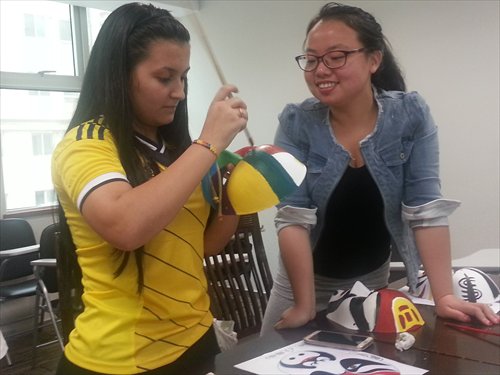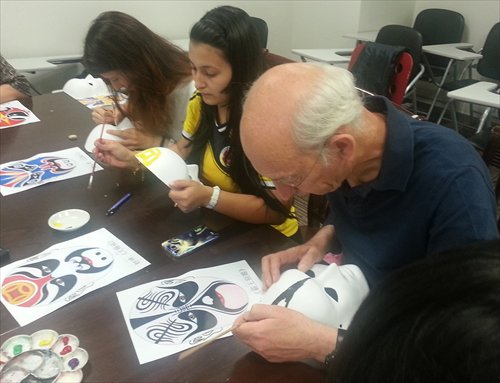HOME >> CHINA, METRO SHANGHAI
Culture unmasked
By Du Qiongfang Source:Global Times Published: 2014-6-29 18:53:01
Peking Opera masks are an essential part of the costume of a Peking Opera performer. It is also an art form featuring traditional Chinese culture, which is adored by many people from home and abroad.
Seven overseas students learned how to paint Peking Opera masks Tuesday at Mandarin House, a Chinese language training school.
It is said that the original Peking Opera masks, which appeared about 150 years ago, were based on the masks worn by ancient warriors.
Peking Opera has four types of characters: sheng, dan, jing and chou. Sheng refers to male characters, and dan refers to female characters. Jing refers to rough mighty men and chou refers to male and female comedy roles. The makeup for sheng and dan is simpler than the others. Performers who play the roles of sheng and dan have only a little makeup on their faces. Painting Peking Opera masks mainly applies to the facial designs for the jing and chou roles.
Each mask has many different colors, but each mask only has one primary color that covers the majority of the mask. Different colors are used in facial designs to represent the different personalities of the characters. Loyal, courageous and honorable characters wear red masks. White is used for sinister and cunning characters. Black is used for righteous characters. Blue represents tranquility and intelligence. Yellow signifies violence and brutality. Purple indicates modest and cool-headed. Green is used for characters who are impatient and reckless. Pink is used for elderly people. Gold is used for gods and spirits.
A mask's primary color gives the audience a rough idea about the personality of each character in the opera.
Peking Opera has hundreds of plays with multiple masks for each character. Although the masks have different patterns, they are designed according to certain rules. Different facial patterns and symbols on the mask's forehead can also offer a hint at the character's personality.
The combination of a primary color and a specific symbol shows a more complicated personality of the character and the plot development of the play. For example, a coin on the forehead can represent the god of fortune. When combined with a primary color, it can represent the personality of the god of fortune.
By learning which colors stand for which personality, the students who took part in the activity got to know a little about Peking Opera masks and gained a better understanding of its characters. They also learned many Chinese adjectives to describe different personality.
The instructor, Wang Fei, picked out some typical Peking Opera characters whose masks are representative of certain major colors, such as Zhao Kuangyin, the emperor of Song Dynasty (960-1279), whose mask is usually red.
With pencils, the students first sketched the outlines of the patterns on the blank masks. Then they filled in the patterns with a color to express the personality that they wanted the mask to display. The students were asked to choose a color to show their own personality.
Japan Intakalaya, from Thailand, who was on a four-week trip to Shanghai, has been learning Chinese for five years in Thailand. "Maybe I understand the Chinese language but I maybe do not understand Chinese culture. These kinds of activities can help me learn more about Chinese culture. If I join another mask painting activity, I'd like to learn more about the stories behind the Peking Opera masks," Intakalaya said.
Godfrey Lee, from the US, has been living in Shanghai for one year. He started learning Chinese two months ago. He chose red as the primary color for his mask to show loyalty.
Raquel Morales, from Panama, has been living in Shanghai for one and a half years and has been learning Chinese for seven months. She took her son to the activity because she thought painting the masks would be fun. "I'd like to know if the mask is only for the opera or it has other purposes," she said.
Karel, from the Netherlands, has been traveling in Shanghai for a week and will take the Chinese language course for two weeks. "The activity gave me a better idea about China than what you can see by walking on the streets or at the tourist attractions," Karel said.
Estefany Ramirez, from Columbia, just arrived in Shanghai. The Peking Opera mask activity was her first Chinese language and culture class. It was the first time that she painted a mask, but she painted it very well.
"This is a new way to learn something. I like it," Ramirez said.
Enrica, from Italy, has been learning Chinese for one year. "Although both Italy and China have their own masks, the patterns and the cultures behind the masks are totally different," Enrica said.


Seven overseas students learned how to paint Peking Opera masks Tuesday at Mandarin House, a Chinese language training school.
It is said that the original Peking Opera masks, which appeared about 150 years ago, were based on the masks worn by ancient warriors.
Peking Opera has four types of characters: sheng, dan, jing and chou. Sheng refers to male characters, and dan refers to female characters. Jing refers to rough mighty men and chou refers to male and female comedy roles. The makeup for sheng and dan is simpler than the others. Performers who play the roles of sheng and dan have only a little makeup on their faces. Painting Peking Opera masks mainly applies to the facial designs for the jing and chou roles.
Each mask has many different colors, but each mask only has one primary color that covers the majority of the mask. Different colors are used in facial designs to represent the different personalities of the characters. Loyal, courageous and honorable characters wear red masks. White is used for sinister and cunning characters. Black is used for righteous characters. Blue represents tranquility and intelligence. Yellow signifies violence and brutality. Purple indicates modest and cool-headed. Green is used for characters who are impatient and reckless. Pink is used for elderly people. Gold is used for gods and spirits.
A mask's primary color gives the audience a rough idea about the personality of each character in the opera.
Peking Opera has hundreds of plays with multiple masks for each character. Although the masks have different patterns, they are designed according to certain rules. Different facial patterns and symbols on the mask's forehead can also offer a hint at the character's personality.
The combination of a primary color and a specific symbol shows a more complicated personality of the character and the plot development of the play. For example, a coin on the forehead can represent the god of fortune. When combined with a primary color, it can represent the personality of the god of fortune.
By learning which colors stand for which personality, the students who took part in the activity got to know a little about Peking Opera masks and gained a better understanding of its characters. They also learned many Chinese adjectives to describe different personality.
The instructor, Wang Fei, picked out some typical Peking Opera characters whose masks are representative of certain major colors, such as Zhao Kuangyin, the emperor of Song Dynasty (960-1279), whose mask is usually red.
With pencils, the students first sketched the outlines of the patterns on the blank masks. Then they filled in the patterns with a color to express the personality that they wanted the mask to display. The students were asked to choose a color to show their own personality.
Japan Intakalaya, from Thailand, who was on a four-week trip to Shanghai, has been learning Chinese for five years in Thailand. "Maybe I understand the Chinese language but I maybe do not understand Chinese culture. These kinds of activities can help me learn more about Chinese culture. If I join another mask painting activity, I'd like to learn more about the stories behind the Peking Opera masks," Intakalaya said.
Godfrey Lee, from the US, has been living in Shanghai for one year. He started learning Chinese two months ago. He chose red as the primary color for his mask to show loyalty.
Raquel Morales, from Panama, has been living in Shanghai for one and a half years and has been learning Chinese for seven months. She took her son to the activity because she thought painting the masks would be fun. "I'd like to know if the mask is only for the opera or it has other purposes," she said.
Karel, from the Netherlands, has been traveling in Shanghai for a week and will take the Chinese language course for two weeks. "The activity gave me a better idea about China than what you can see by walking on the streets or at the tourist attractions," Karel said.
Estefany Ramirez, from Columbia, just arrived in Shanghai. The Peking Opera mask activity was her first Chinese language and culture class. It was the first time that she painted a mask, but she painted it very well.
"This is a new way to learn something. I like it," Ramirez said.
Enrica, from Italy, has been learning Chinese for one year. "Although both Italy and China have their own masks, the patterns and the cultures behind the masks are totally different," Enrica said.

Instructor Wang Fei helps Columbian Estefany Ramirez create a Peking Opera mask.

(From left to right) Enrica, Ramirez and Karel paint their masks.
Photos: Du Qiongfang/GT
Posted in: Society, Metro Shanghai